Bitcoin price today: falls to 2-week low below $113k ahead of Fed Jackson Hole
Introduction & Market Context
Lincoln Educational Services (NASDAQ:LINC), a leading provider of specialized technical training, presented strong second-quarter 2025 results on August 11, highlighting substantial growth across key metrics despite subsequent stock volatility. The company continues to capitalize on the growing demand for "middle skills" training, which represents 48% of America’s labor market and requires education beyond high school but not a four-year degree.
As shown in the following chart illustrating the middle skills opportunity, Lincoln Tech is strategically positioned in a segment with significant demand:
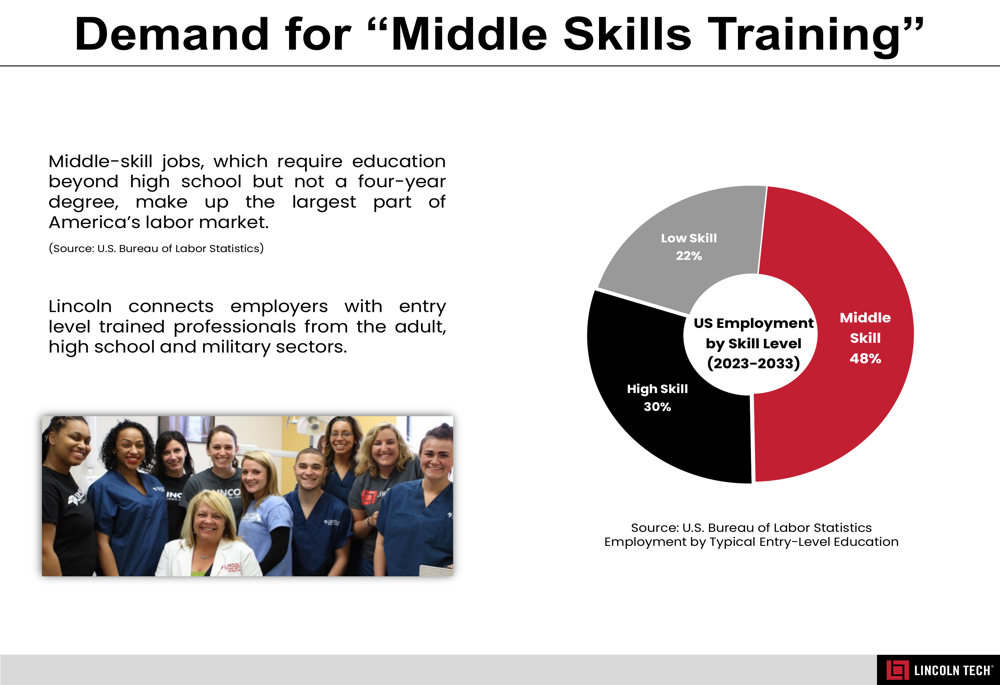
The company’s investment thesis centers on addressing the persistent skills gap, with Lincoln positioned as a leading technical educator serving high-demand industries including transportation, skilled trades, and healthcare. Management emphasized their proven ability to grow in both high and low unemployment markets while maintaining strong profitability.
As shown in the following investment opportunity overview:
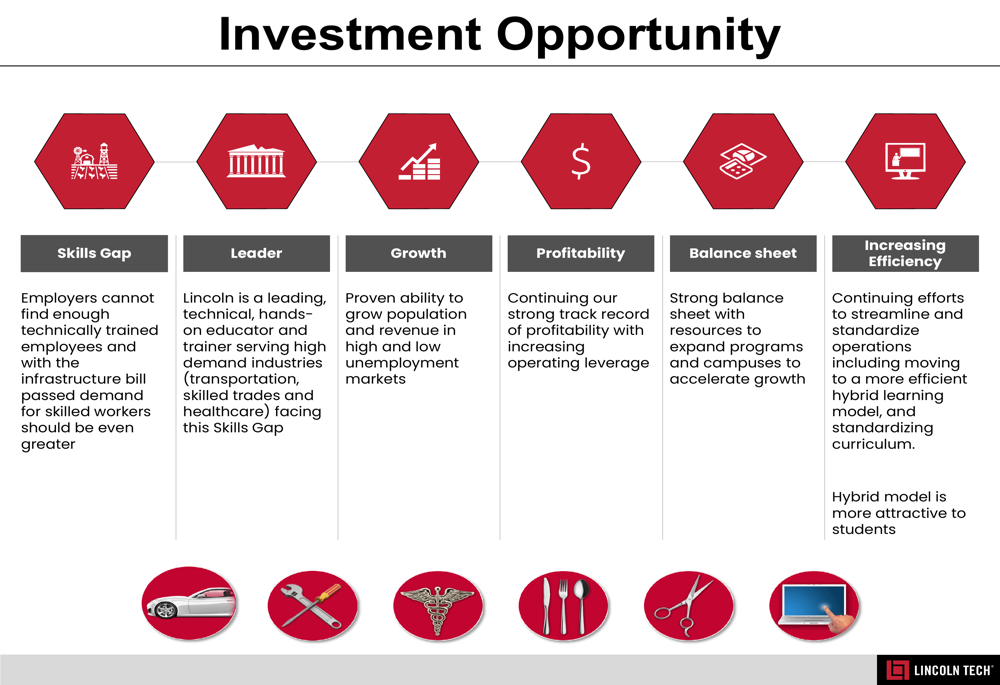
Quarterly Performance Highlights
Lincoln Educational reported impressive Q2 2025 financial results, with revenue increasing 15% year-over-year to $116.5 million. Student starts grew by 22% to approximately 5,900, while adjusted EBITDA jumped 56% to $10.5 million compared to the prior year. The company also reported earnings per share of $0.05, compared to a loss of $0.02 in the same quarter last year, while adjusted EPS reached $0.09 versus $0.05 in the prior year.
The following slide details these strong quarterly results and the company’s decision to raise full-year guidance:
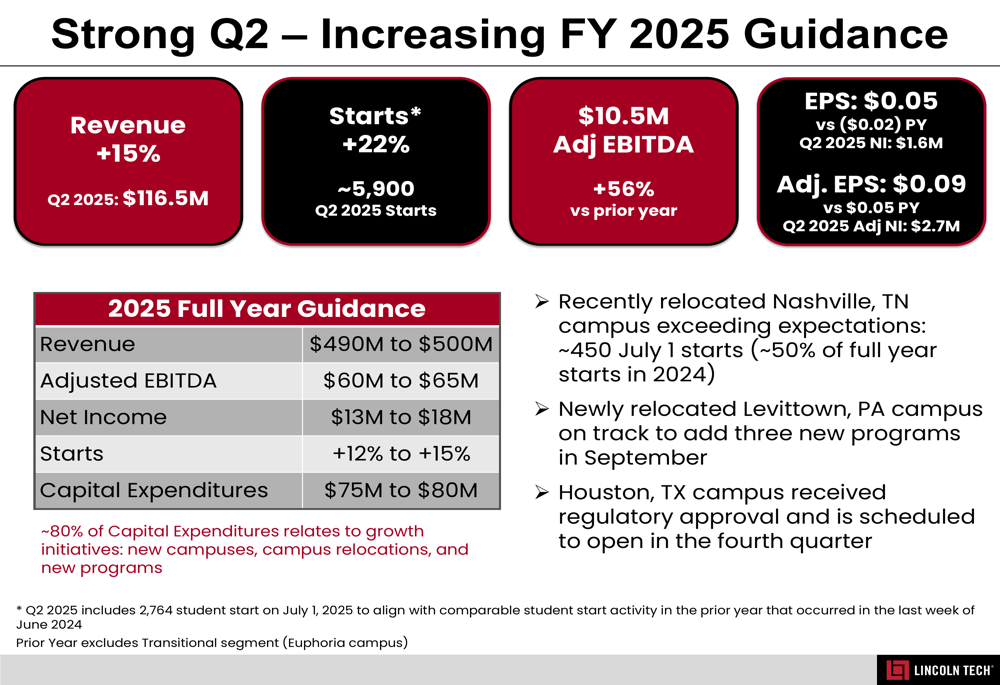
The company’s financial performance has shown consistent improvement over recent years, with EBITDA margins expanding from 2.7% in Q2 2022 to 9.0% in Q2 2025. This trend is clearly illustrated in the following revenue and margin progression chart:

Student metrics have also shown robust growth, with average student population reaching 16,014 in Q2 2025, up from 13,492 in Q2 2024. This growth trajectory is visualized in the following chart:
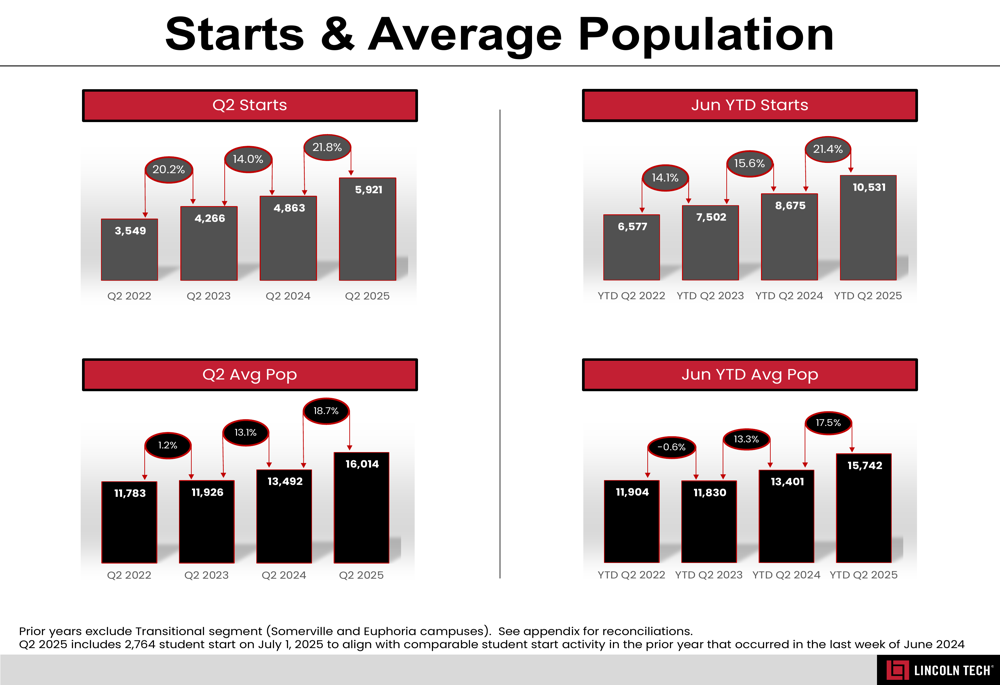
Despite these strong results, Lincoln’s stock experienced significant volatility following the earnings announcement. According to the earnings article, the stock fell 12.21% to $23.75 after the release, despite rebounding 9.94% in pre-market trading the following day. Current fundamentals data shows the stock trading at $19.18, down 2.74%, indicating continued market uncertainty despite the company’s operational success.
Strategic Initiatives and Growth Plans
Lincoln Educational is actively expanding its campus footprint and program offerings to capitalize on the significant market opportunity. The company currently operates 21 campuses across 12 states and is adding two new locations, including a Nashville campus that is exceeding expectations and a Houston campus scheduled to open in Q4 2025.
The company’s geographic distribution is illustrated in the following map:
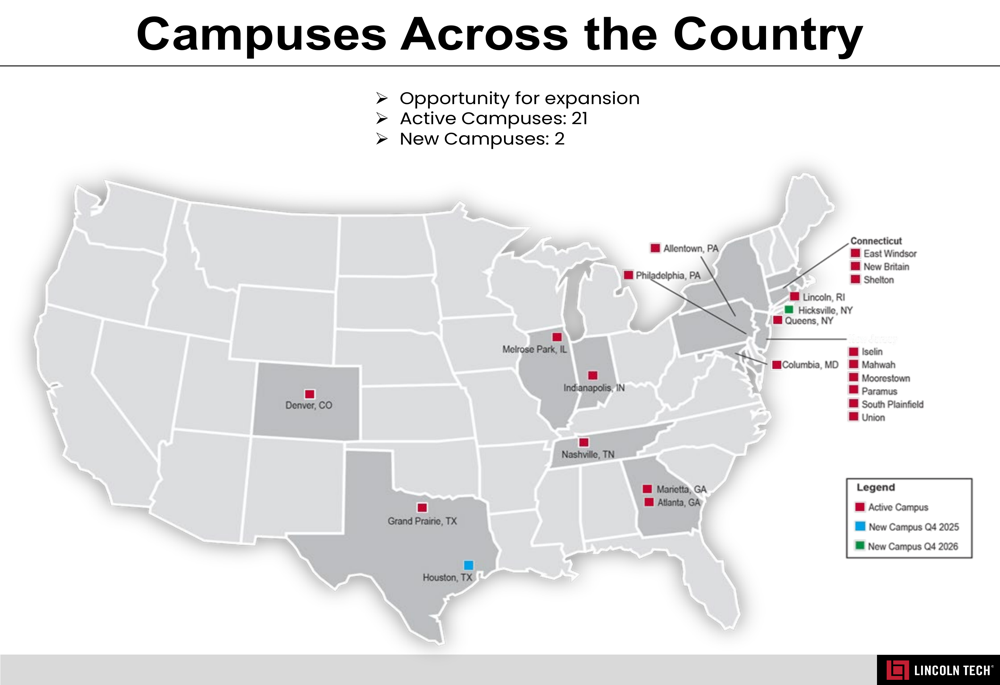
Lincoln’s growth strategy includes both organic expansion and potential acquisitions. Management projects that new campuses can generate approximately $7 million in EBITDA after 36 months of operations. The company’s long-term goals include increasing its campus count to 23 while growing adjusted EBITDA to $90 million by 2027.
The following slide outlines Lincoln’s long-term financial projections:
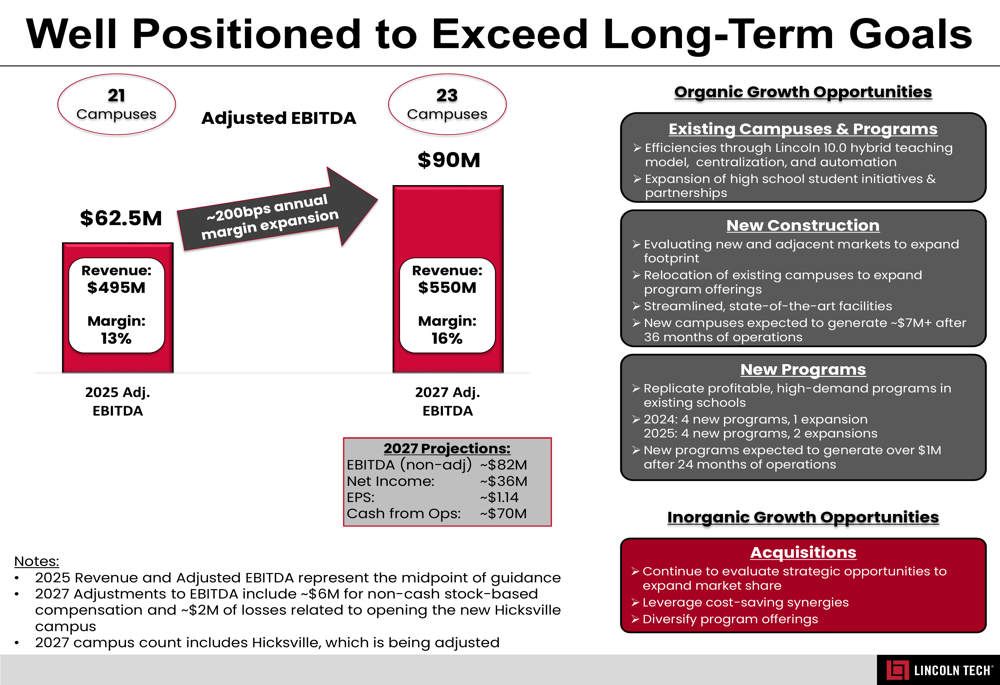
A key component of Lincoln’s expansion strategy is its hybrid learning model, which combines hands-on training with online education. This approach allows for more efficient use of facilities while providing students with flexible learning options. The economics of this model are detailed in the following pro-forma:

Forward-Looking Statements
Based on strong Q2 performance, Lincoln Educational raised its full-year 2025 guidance, now projecting revenue between $490 million and $500 million, adjusted EBITDA of $60 million to $65 million, and net income of $13 million to $18 million. The company expects student starts to grow 12% to 15% for the full year.
Management is confident in exceeding its previously stated 2027 objectives of approximately $550 million in revenue and $90 million in adjusted EBITDA. The company’s capital expenditure guidance of $75 million to $80 million for 2025 reflects its commitment to growth initiatives, with approximately 80% of this spending allocated to expansion projects.
Lincoln’s market opportunity remains substantial, with the company currently capturing only about 1.9% of annual new hires across its top programs. The Bureau of Labor Statistics data shows significant annual demand for graduates in fields such as medical assisting (119,800), electrical (80,200), and automotive technology (67,800).
The following slide illustrates this organic growth opportunity:
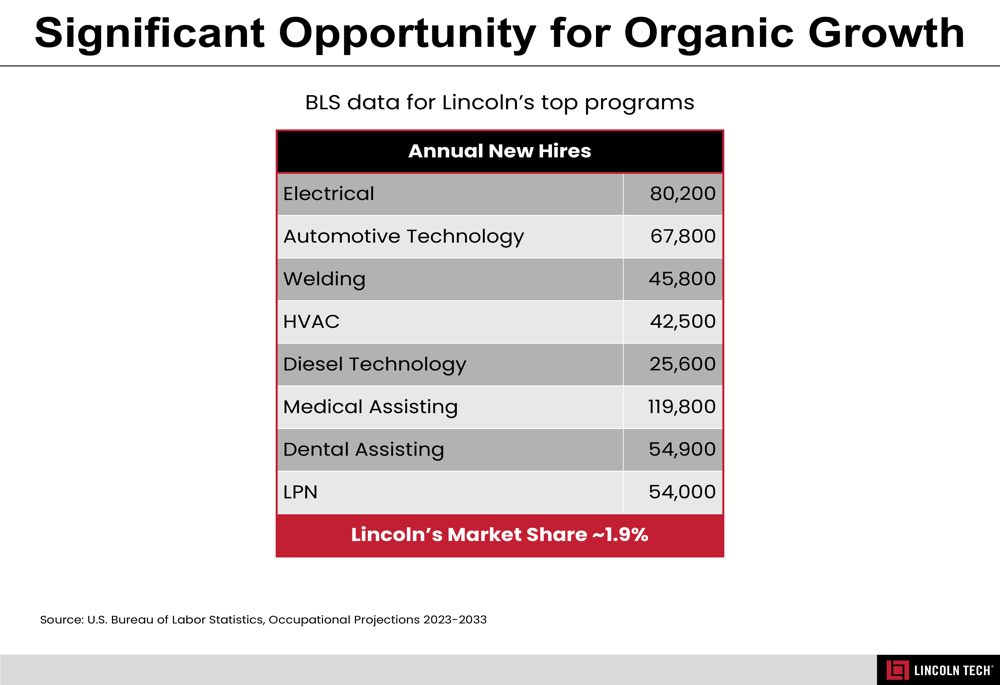
Investment Considerations
Lincoln Educational presents several compelling investment merits, including its leadership position in hands-on technical education, organic revenue growth with increasing profitability, and significant expansion opportunities. The company benefits from strong industry partnerships and maintains a solid regulatory record with strong student outcomes.
The key investment considerations are summarized in the following slide:

However, investors should note potential risks mentioned during the earnings call, including challenges with military veteran enrollment and ongoing restructuring of healthcare programs. The company’s stock volatility despite strong operational performance suggests market uncertainty about the sustainability of growth or concerns about valuation.
Lincoln maintains a strong balance sheet with nearly $65 million in liquidity, positioning it well to execute on its growth initiatives. With a market capitalization of approximately $720 million and institutional ownership of 75.3%, the company has attracted significant professional investor interest.
As the skills gap in middle-skill jobs continues to widen due to factors like the "Silver Tsunami" of retiring baby boomers and increased infrastructure spending, Lincoln Educational appears well-positioned to capitalize on growing demand for technical education while executing on its expansion strategy.
Full presentation:
This article was generated with the support of AI and reviewed by an editor. For more information see our T&C.
